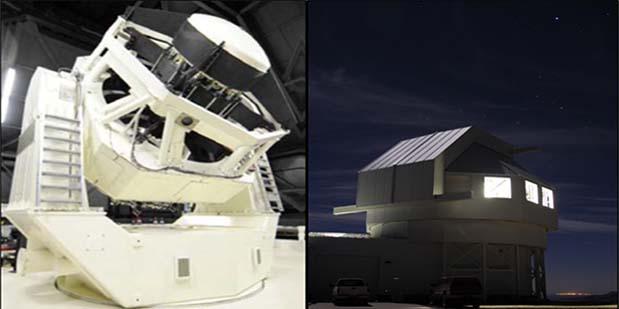U.S. Air Force Inherits Powerful New Space Telescope from DARPA
The U.S. Air Force on Tuesday inherited a next-generation telescope capable of detecting and tracking space debris with unprecedented fidelity. The Defense Advanced Research Projects Agency, or DARPA, transferred to the U.S. Air Force Space Command its space surveillance telescope (SST), a revolutionary device designed to track objects in Earth’s orbit.
The U.S. Air Force on Tuesday inherited a next-generation telescope capable of detecting and tracking space debris with unprecedented fidelity. The Defense Advanced Research Projects Agency, or DARPA, transferred to the U.S. Air Force Space Command its space surveillance telescope (SST), a revolutionary device designed to track objects in Earth’s orbit.
“The demand of space, including geosynchronous orbit, or GEO orbit, is critical to daily life today, including providing communication capability [and] defense capability,” DARPA Program Manager Lindsay Millard told reporters. “And while it’s not exactly crowded up there in the traditional sense—it’s not like a crowded subway car or a lot of traffic—there are tens of thousands of satellites and other objects in GEO. So we have to be aware.”
The DARPA-developed telescope can scan large sections of space and enhances space situational awareness. Instead of viewing the sky through a drinking straw, observers now can view tens of thousands of objects—even objects as small as a softball—through a windshield. “Before SST, there was no single telescope that could handle both of those challenges—finding and tracking very small, faint objects very far away and over an enormously vast area in space,” Millard said.
Data collected from the surveillance of space will help scientists predict possible collisions with Earth of asteroids and other near-Earth objects. “With 2.2 million asteroid observations in 2014, 7.2 million in 2015 and hopes for about 10 million in 2016, SST has become the most prolific tool for asteroid observation in the world,” she said. “SST has also discovered 3,600 new asteroids and 69 near-Earth objects, including four that came within a distance from Earth that I’d like to qualify as non-trivial.”
The uptick in observations is the result of three improvements, she said. Over the past several years, DARPA upgraded its telescope concept of operation for better and faster performance; enhanced algorithms so researchers can better process more data; and improved the camera to allow them to see fainter objects that previously had gone undetected.
Militarily, the telescope will allow the Air Force to view and catalog more items than before. “We can see many more uncorrelated tracks than the Air Force can today,” Millard said, declining to provide more details. “In fact, SST has about an order of magnitude better performance than the existing space surveillance network optical sensor called GEODSS,” she said of the Ground-Based Electro-Optical Deep Space Surveillance system.
The SST is focused on tracking space objects and debris that reside more than 22,000 miles above the Earth. “Beside the fact that this is very far away … the mission is made especially difficult because of the huge amount of space we’re talking about,” she said.
Engineers developed several technological firsts during the SST program. The telescope uses the steepest curved primary telescope mirror ever made. The mirror, developed by L3, enables the device to collect more light across a wider field of view than any other telescope. To use light from that mirror, MIT Lincoln Laboratory, a federally funded research and development center, developed the first ever curved charge-coupled device, or CCD, for the camera to provide clear imagery across the wide field of view. “This is a huge technological advancement, and perhaps the only place in the world with the expertise to make this right now is at Lincoln Lab,” Millard said. The camera features one of the fastest shutters in the world, which she described as sounding like a microwave oven with a shutter clicking in the background.
“NASA and MIT Lincoln Labs recently started applying SST data to statistical studies to answer the fundamental question: How much debris exists in the entirety of space around the Earth?” Millard said.
The telescope will be transferred to western Australia, to scan the skies in an area where the United States does not have a lot of sensors. The Australian government will build the dome for the telescope, and U.S. Air Force officials will disassemble the telescope from its current location in New Mexico and prep it for transport in shipping containers via ship. The current schedule is for the telescope to be operational in Australia in 2020. The U.S. Air Force will operate the telescope with the Australian Royal Air Force.
There is no word yet on whether the U.S. military plans to acquire more telescopes. But in order to see the entire GEO belt, it would need four SSTs placed around the globe, Millard said.
Listen to Millard discuss the SST on the latest Voices from DARPA podcast, available on SoundCloud, YouTube or iTunes.




Comments